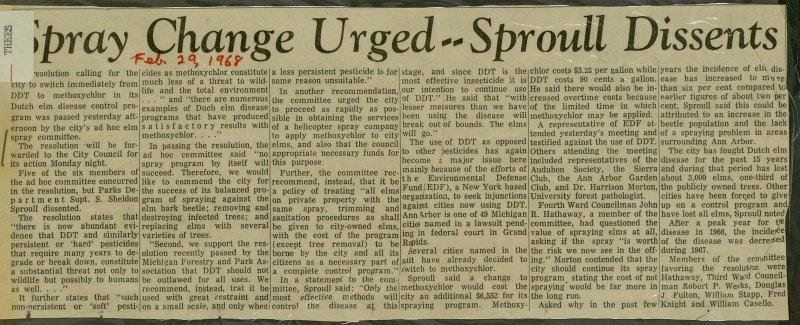Spray Change Urged--sproull Dissents

esolution calling for the city to switch immediately from DDT to methoxychlor in its Dutch elm disease control program was passed yesterday aftt ernoon by the city's ad hoc elm [spray committee. The resolution will be forwarded to the City Council for its action Monday night. Five of the six members of the ad hoc committee concurred in the resolution, but Parks Department Supt. S. Sheldon Sproull dissented. The resolution states that "there is now abundant evidence that DDT and similarly persistent or 'hard' pesticides that require many years to degrade or break down, constitute a substantial threat not only to wildlife but possibly to humans as well. . . ." It further states that "such non-nersistent or 'soft' cides as methoxychlor consütute much less of a threat to wildlife and the total environment ... . " and "there are numerous examples of Duch elm disease programs that have produced satisfactory results with methoxychlor. . . ." In passing the resolution, the ad hoc committee said "no spray program by itself will succeed. Therefore, we would like to commend the city for the success of its balancea program of spraying against the elm bark beetle; removing and destroying infected trees; and replacing elms with several varieties of trees. "Second, we support the resolution recently passed by the Michigan Forestry and Park Association that DDT should not be outlawed for all uses. We recommend, instead, trat it be used with great restraint and on a small scale, and only whpfi a less persistent pesticide is for some reason unsuitable." In another recommendation, the committee urged the city to proceed as rapidly as possible in obtaining the services of a helicopter spray company to apply methoxychlor to city elms,, and also that the council appropriate necessary funds for this purpose. Further, the committee recrecommend, instead, that it be a policy of treating "all elms on private property with the same spray, trimming and sanitation procedures as shall be given to city-owned elms, with the cost of the program (except tree removal) to be borne by the city and all its citizens as a necessary part of a complete control program." In a statemeDf to the committee, Sproull said: "Only the most efectiVe methods will contro! the disease af this stage, and since DDT is the most effective insecticide it is our intention to continue use ' of DDT." He said that "with . lesser messures than we have i been usirg the disease will ■ break out of bounds. The elms ■ will go." I The use of DDT as opposed to other pesticides has again become í major issue here mainly because of the efforts of , the Environmental Defense '. Fund(EDF), a New York based orgarizatioii, to seek injunctions Í agaiist cities now using DDT. I Ann rbor is one of 49 Michigan cities named in a lawsuit pend[ ing in federal court in Grand . Rgpids. i áeveral cities named in the sJit have already decided to 1 iwitch to methoxychlor. Sproull said a change to methoxychlor would cost the city an additional $6,552 for its spraying program. chlor costs $3.25 per gallon while DDT costs 90 cents a gallon. He said there would also be increased overtime costs because of the limited time in which methoxychlor may be applied. A reprcsentative of EDF attended yesterday's meeting and testified against the use of DDT. Others attending the meeting included representatives of the Audubon Society, the Sierra Club, the Ann Arbor Garden Club, and Dr. Harrison Morton, University forest pathologist. Fourth Ward Councilman John R. Hathaway, a member of the committee, had questioned the value of spraying elms at all, asking if the spray "is worth the risk we now see in the offing." Morton contended that the city should continue its spray program stating the cost of not spraying" would be far more in the long run. Asked why in the past few years the incidence of eln 1 ease has increased to morel than six per cent compared tol earlier figures of about two per! cent, Sproull said this could be attributed to an increase in the beetle population and the lack of a spraying problem in areas surrounding Ann Arbor. The city has fought Dutch elm disease for the past 15 years and during that period has lost about 3,000 elms, one-third of the publicly owned trees. Other cities have been forced to give up on a control program and] have lost all elms, Sproull notedi After a peak year for fej disease in 1966, the incidece of the disease was decreced! during 1967. Members of the coronitteel favoring the resolutöfl werel Hathaway, Third Wa-'d Council-I man Robert P. Weeks, Douglasl J. Fulton, William Stapp, Fredl Knight ánd William Casello.
Article
Subjects
Pesticides
DDT
Old News
Ann Arbor News